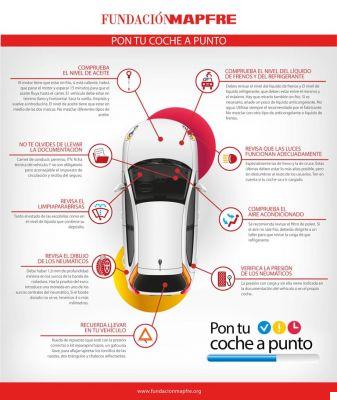
Introduction
Welcome to our article on the importance of checking a car before embarking on a trip. In this text, we'll provide tips and advice to make sure your vehicle is in good shape before you hit the road. We know how important the safety and proper functioning of the car is, so we hope that this information will be useful for all drivers.
1. Tire inspection
One of the most important aspects to take into account before a trip is to check the tires. It is essential to ensure that the tires are in good condition and with the correct pressure. Check for excessive wear, cuts, or bulges on the tires. Also, make sure the tire pressure is as recommended by the vehicle manufacturer. Tires in poor condition or with incorrect pressure can compromise the safety and performance of the car.
What is the proper tire pressure?
The proper pressure for tires can vary depending on the model and make of the car. However, this information can usually be found on the driver's door or in the owner's manual. It is important to follow the manufacturer's recommendations to ensure a safe and comfortable ride.
2. Check the brakes
The brakes are another fundamental element that must be checked before embarking on a trip. Make sure the brakes are in good condition and working properly. Check the thickness of the brake pads and make sure they are not worn. Also, pay attention to any unusual noise or vibration when braking, as this could indicate a problem with the brake system. Do not skimp on the safety of your car and, if necessary, have the brakes checked by a professional.
How often should I change the brake pads?
The frequency with which brake pads should be changed can vary depending on driving style and road conditions. However, as a general rule, it is recommended to change the brake pads every 30.000 to 70.000 kilometers. It's important to watch for any signs of wear, such as squealing or hard braking, and to have your brakes checked regularly.
3. Fluid check
Before a trip, it is essential to check the fluid levels in the car. Make sure the engine oil is at the proper level and that it is not dirty or contaminated. Also check the level of the brake fluid, coolant and power steering fluid. These fluids are essential for the proper functioning of the car and their lack or deterioration can cause serious problems. If necessary, top up fluids or do an oil change before you set off on your journey.
How can I check the engine oil level?
To check the engine oil level, follow these steps:
- Make sure the car is on a level surface and the engine is off.
- Locate the oil dipstick, it usually has a yellow or orange colored handle.
- Remove the dipstick and wipe it with a clean rag.
- Reinsert the dipstick in its place and remove it again.
- Check the oil level on the dipstick. It must be between the min and max marks. If it is below the minimum level, add oil until it reaches the proper level.
Conclusion
In summary, before embarking on a trip, it is essential to check the car to ensure the safety and proper functioning of the vehicle. In this article, we've highlighted the importance of checking your car's tires, brakes, and fluids. Remember to follow the manufacturer's recommendations and, if necessary, see a professional for a more thorough check. Don't skimp on your car's safety and enjoy a smooth and hassle-free trip.
Frequently Asked Questions (FAQs)
1. What is the proper tire pressure?
The proper pressure for tires can vary depending on the model and make of the car. However, this information can usually be found on the driver's door or in the owner's manual. It is important to follow the manufacturer's recommendations to ensure a safe and comfortable ride.
2. How often should I change the brake pads?
The frequency with which brake pads should be changed can vary depending on driving style and road conditions. However, as a general rule, it is recommended to change the brake pads every 30.000 to 70.000 kilometers. It's important to watch for any signs of wear, such as squealing or hard braking, and to have your brakes checked regularly.
3. How can I check the engine oil level?
To check the engine oil level, follow these steps:
- Make sure the car is on a level surface and the engine is off.
- Locate the oil dipstick, it usually has a yellow or orange colored handle.
- Remove the dipstick and wipe it with a clean rag.
- Reinsert the dipstick in its place and remove it again.
- Check the oil level on the dipstick. It must be between the min and max marks. If it is below the minimum level, add oil until it reaches the proper level.
We hope these frequently asked questions have clarified some common doubts about having a car checked before a trip. If you have any other questions, feel free to leave a comment and we'll be happy to help.
Thanks for reading our article and we hope it was useful to you! Always remember to check your car before embarking on a trip to ensure your safety and that of your companions. If you have any additional experience or tips, feel free to share them in the comments. We would love to hear your opinion!
Until next time,
The Pistonudos.com team


























